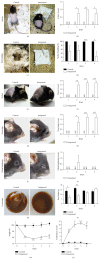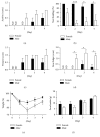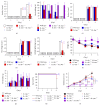Imiquimod Treatment Causes Systemic Disease in Mice Resembling Generalized Pustular Psoriasis in an IL-1 and IL-36 Dependent Manner
- PMID: 28057979
- PMCID: PMC5183767
- DOI: 10.1155/2016/6756138
Imiquimod Treatment Causes Systemic Disease in Mice Resembling Generalized Pustular Psoriasis in an IL-1 and IL-36 Dependent Manner
Abstract
Generalized pustular psoriasis (GPP) is a severe form of psoriasis that can be caused by missense mutations in the interleukin-36 (IL-36) receptor antagonist. In addition to neutrophil rich skin inflammation, GPP patients typically also experience anorexia, fever, malaise, and pain. The imiquimod-induced skin inflammation mouse model has rapidly become a popular way to study plaque psoriasis, which typically does not involve symptoms of systemic disease. In this model, neutrophil recruitment to the skin is dependent upon the inflammatory mediators IL-1, via its receptor IL-1R1, and IL-36α. Unexpectedly, we observed that mice also exhibited signs of anorexia (weight loss and decreased food intake), general malaise (decreased activity and loss of interest in building nests), and pain (nose bulging and hunched posture). A scoring system allowing quantitative comparisons of test groups was developed. Female mice were found to develop more severe disease than male mice. Furthermore, mice deficient in both IL-1R1 and IL-36α are nearly disease-free, while mice lacking only one of these inflammatory mediators have less severe disease than wild type mice. Hence, the imiquimod-induced skin inflammation mouse model recapitulates not only plaque psoriasis, but also the more severe symptoms, that is, anorexia, malaise, and pain, seen in GPP.
Conflict of interest statement
The authors declare that there are no competing interests regarding the publication of this paper.
Figures




References
MeSH terms
Substances
Grants and funding
LinkOut - more resources
Full Text Sources
Other Literature Sources
Medical
Molecular Biology Databases

